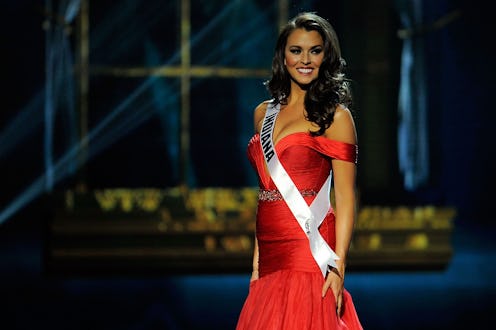When Mekayla Diehl took the stage at the Miss USA pageant on June 8, pretty much everyone had something to say about it — although not, somewhat surprisingly, because she made history as the first registered Native American to represent Indiana in the pageant. Instead, she was singled out by many because of her body. This in and of itself wouldn’t be unusual — we are talking about a beauty pageant here — but what makes this case notable is the sheer range of responses. Many praised the fact that she had curves, and that her body was “normal”; others agreed that, while she was a different physical type than we often see on the pageant circuit (and in the fashion world), her slim figure was still far from that of the typical woman.
Both extremes, however, have become problematic the more they’ve been discussed: As The Gloss pointed out, a number of those coming from the “real women have curves” school of thought have started doing the opposite of fat shaming — thin shaming. Meanwhile, some of those coming from the “she’s not normal perspective have begun calling it dangerous that Diehl is being referred to as “normal” in the first place. The Washington Post, for example, spoke to Northwestern University psychologist Renee Engeln, who believes the “the glamorization of Miss Indiana’s comparatively ‘normal’ size… is ironic and borderline damaging.” And although the Daily Beast’s Erin Cunningham was a bit more diplomatic about it, she still noted, “Diehl is gorgeous. And she has a healthy physique not normally seen in pageants that she should be applauded for. But is she ‘normal’? No. She’s still skinny.”
But I think we’re talking about the issue all wrong. At 5'8" and either a size four or a size eight (there’s some debate about which she is, putting aside the fact that I hate that we’re analyzing her clothing size to begin with), yes, Diehl is different than what we’re used to seeing waltz down the catwalk, but no, she’s not what’s generally considered plus size, either. She’s fit and clearly makes an effort to stay in shape, without hewing to the physical standard for professional pretty people. The important thing to note, though, isn’t the individual numbers. It’s not that she’s lower than the national averages, or higher than the average runway model. It’s that she’s at the right size for herself. And that, ultimately, is why I think Diehl is important.
The trouble, I think, is this: “average” is a mathematical figure, but “normal” is relative. What’s normal for one person may not be normal for another, and using the same standards to judge everyone doesn’t do anyone any favors. Fat shaming is obviously no good, but neither is thin shaming. Healthy bodies come in all shapes and sizes, whether they’re “bean poles” or “bombshells” — something of which I think we sometimes lose sight, and of which we’d do well to remind ourselves every now and again. Substitute "everyone" for "everything" in the GIF below, and well, you'll get what I mean.
Sometimes I find it difficult to talk about “size” because of how my own clothing size compares with the average American woman’s size, which is a 14. I’m usually somewhere between a size zero and a size two depending on the brand, which I worry negates my point of view or somehow renders me “not allowed” to address issues of body image and body positivity. However, I’m also only a little over five feet tall. I’m bad about working out, and although I generally try to eat healthily, sometimes I indulge in my favorite treats a little more than I probably should. Yes, my numbered size is significantly under the national average, but I’m by no means model-thin. I may not be “average,” but I’m “normal” — normal for me, that is. Diehl’s body is normal for her, just as Taylor Townsend’s is normal for her. We all have our own normal, even if we aren’t average.
Hayley Hoover over at The Gloss noted in her Twitter thin shaming piece, “I think it’s important to remember that while all women with curves are sexy, not all sexy women have curves.” Truth. Context is always important, and when it comes to health, that context is the individual to whom the body in question belongs. Isn’t it about time we started celebrating all bodies independently of one another, instead of constantly comparing them to somebody else’s?
